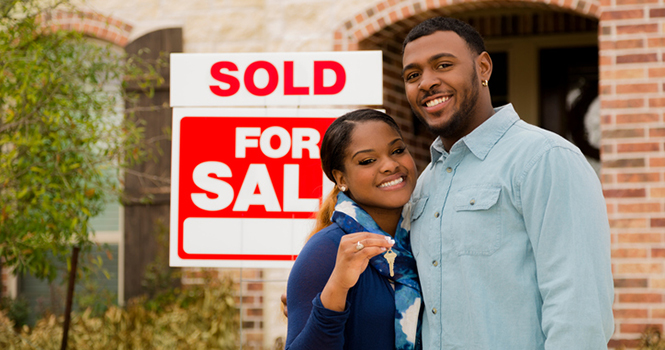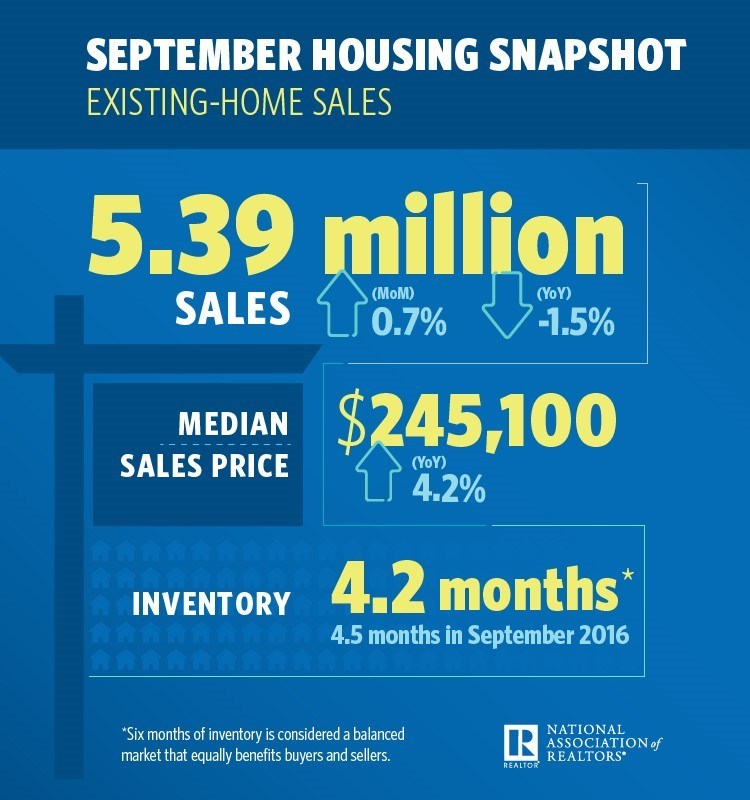Existing-home sales slightly stirred in September, posting higher than in August but lower than one year prior, the National Association of REALTORS® (NAR) reports.
Existing-home sales totaled 5.39 million, a 0.7 percent increase from August but a 1.5 percent decrease from one year prior. Inventory increased 1.6 percent to 1.90 million, 6.4 percent below one year prior.
“Home sales in recent months remain at their lowest level of the year and are unable to break through, despite considerable buyer interest in most parts of the country,” says Lawrence Yun, chief economist at NAR. “REALTORS® this fall continue to say the primary impediments stifling sales growth are the same as they have been all year: not enough listings—especially at the lower end of the market—and fast-rising prices that are straining the budgets of prospective buyers.”
Inventory is currently at a 4.2-month supply. Existing homes averaged 34 days on market in September, five days less than one year prior. All told, 48 percent of homes sold in September were on the market for less than one month.
“Existing-home sales picked up momentum slightly in September compared to August, but were lower on a year-over-year basis for the first time since July 2016,” says Danielle Hale, chief economist for realtor.com®. “Inventories also continue to plunge, creating challenges for buyers across the country. On the bright side, we’re starting to see home price growth slow down, with sale prices up only 4.2 percent from a year ago.”
The metropolitan areas with the fewest days on market in September, according to data from realtor.com, were San Francisco-Oakland-Hayward, Calif. (30 days); San Jose-Sunnyvale-Santa Clara, Calif. (32 days); Salt Lake City, Utah (35 days); and Seattle-Tacoma-Bellevue, Wash., and Vallejo-Fairfield, Calif. (both 36 days).
The median existing-home price for all types of houses (single-family, condo, co-op and townhome) was $245,100, a 4.2 percent increase from one year prior. The median price for a single-family existing home was $246,800, while the median price for an existing condo was $231,300.
“A continuation of last month’s alleviating price growth, which was the slowest since last December (4.5 percent), would improve affordability conditions and be good news for the would-be buyers who have been held back by higher prices this year,” Yun says.
Single-family existing-home sales came in at 4.79 million in September, a 1.1 percent increase from 4.74 million in August, but a 1.2 percent decrease from 4.85 million one year prior. Existing-condo and -co-op sales came in at 600,000, a 1.6 percent decrease from August and a 3.2 percent decrease from one year prior.
Twenty percent of existing-home sales in September were all-cash, with 15 percent by individual investors. Four percent were distressed.
The Midwest and West saw positive activity in September, with existing-home sales rising 1.6 percent to 1.30 million in the Midwest, with a median price of $195,800, and 3.3 percent to 1.24 million in the West, with a median price of $362,700. Existing-home sales in the South fell, 0.9 percent to 2.13 million, with a median price of $215,100. Existing-home sales in the Northeast were unmoved at 720,000, with a median price of $274,100.
“Home sales in the South continue to be hampered by post-hurricane weakness, while the Midwest and West regions show pretty strong pick-up in sales from August. It should be noted that the fires in California are not yet reflected in the data, so we’re likely to see more weakness on the horizon,” Hale says.
“Sales activity likely would have been somewhat stronger if not for the fact that parts of Texas and South Florida—hit by Hurricanes Harvey and Irma—saw temporary, but notable declines,” says Yun.
First-time homebuyers comprised 29 percent of existing-home sales in September, a decrease from 31 percent in August.
“Nearly two-thirds of renters currently believe now is a good time to buy a home, but weakening affordability and few choices in their price range have made it really difficult for more aspiring first-time buyers to reach the market,” Yun says.
Adds Hale, “Interestingly, the softening in prices has not yet affected home listing prices. According to realtor.com data, the number of homes for sale are down 9 percent from a year ago, while listing prices – which continue to soar – are up 10 percent. The discrepancy between list price and sales price increases suggests that some buyers may have reached a limit on the price increases they can afford.”
NAR President Bill Brown is concerned first-time homebuyers, and homeowners in general, will be adversely impacted by proposed tax reform.
“There’s no way around the fact that any proposal that marginalizes the mortgage interest deduction and eliminates state and local tax deductions essentially disincentives homeownership and is a potential tax hike on millions of middle-class homeowners,” says Brown. “Reforming the tax code is a worthy goal, but it should not lead to the middle class, who primarily build wealth through owning a home, footing the bill. Instead, Congress should be looking at ways to ensure more creditworthy prospective buyers are able to achieve homeownership and enjoy its personal and wealth-building benefits.”
For more information, please visit www.nar.realtor.
For the latest real estate news and trends, bookmark RISMedia.com.












